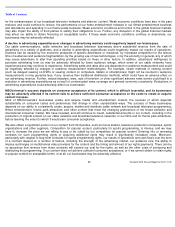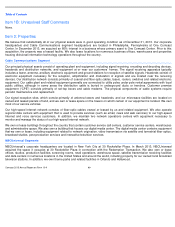Comcast 2013 Annual Report Download - page 37
Download and view the complete annual report
Please find page 37 of the 2013 Comcast annual report below. You can navigate through the pages in the report by either clicking on the pages listed below, or by using the keyword search tool below to find specific information within the annual report.
Table of Contents
of its films, for the exhibition of its films in theaters, and for shelf space in retail stores for its DVDs and with digital distributors for
the licensing and sale of its products. It also competes for consumers with other film producers and distributors and all other forms
of entertainment inside and outside the home.
Our cable communications business, cable networks, broadcast television networks and owned local broadcast television stations
compete for the sale of advertising time with other television networks and stations, as well as with all other advertising platforms,
such as radio stations, print media and websites. Additionally, our ability to compete depends on our perceived image and
reputation among our various constituencies, including our customers, consumers, advertisers, investors and governmental
authorities.
For a more detailed description of the competition facing all of our businesses, see “Business – Competition”
above. There can be
no assurance that we will be able to compete effectively against existing or new competitors or that competition will not have an
adverse effect on our businesses.
Changes in consumer behavior driven by new technologies may adversely affect our businesses.
We operate in a highly competitive, consumer-
driven and rapidly changing environment. New technologies, particularly alternative
methods for the distribution, sale and viewing of content, have been, and will likely continue to be, developed that further increase
the number of competitors that all our businesses face and that drive changes in consumer behavior. These technologies may
affect demand for all of our products and services as the number of entertainment choices available to, and the manner in which
they are delivered to, consumers continue to increase and evolve. Our failure to effectively anticipate or adapt to emerging
technologies or changes in consumer behavior could have an adverse effect on our businesses.
Newer services and technologies that may compete with our video services include digital distribution services and devices that
offer Internet video streaming and downloading of movies, television shows and other video programming that can be viewed on
television sets and computers, as well as other devices such as smartphones and tablets. Some of these services charge a nominal
or no fee for access to their content, which could adversely affect demand for our video services, including for premium networks
and our DVR, On Demand and streaming services. In addition, consumers are increasingly interested in accessing information,
entertainment and communications services anywhere and anytime they want; newer services in wireless Internet technology such
as 4G wireless broadband services and Wi-
Fi networks, and devices such as wireless data cards, tablets, smartphones and mobile
wireless routers that connect to such devices, may compete with our high
-
speed Internet services. Our voice services are facing
increased competition from wireless and Internet-
based phone services as more people choose to replace their traditional wireline
phone service with these phone services. The success of any of these ongoing and future developments may have an adverse
effect on our cable communications’ competitive position, business and results of operations.
New technologies are also affecting consumer behavior in ways that are changing how content is viewed as consumers seek more
control over when, where and how they consume content, which may have a negative impact on our businesses and results of
operations. For example, the increased availability of DVRs, video-on-
demand services and cable, broadcast and other video
programming on the Internet (including high-
quality original video programming that may be viewed only through digital distribution
services), as well as increased access to various media through wireless devices, have the potential to reduce the viewing of our
content through traditional distribution outlets, which could adversely affect the demand for our video services, the price and
amount of advertising that advertisers are willing to purchase from us, the amount multichannel video providers are willing to pay to
NBCUniversal for its content and the levels of DVD and theatrical sales. These new technologies have increased the number of
entertainment choices available to consumers and intensified the challenges posed by audience fragmentation. Some of these
newer technologies also give consumers greater flexibility to watch programming on a time-delayed or on-demand basis or to fast-
forward or skip advertisements within programming, which also may adversely impact the advertising revenue we receive. Delayed
Comcast 2013 Annual Report on Form 10
-
K
32
























